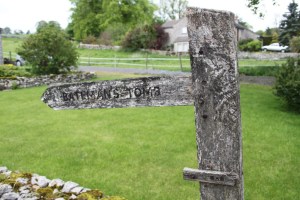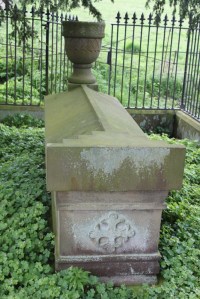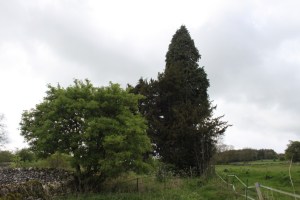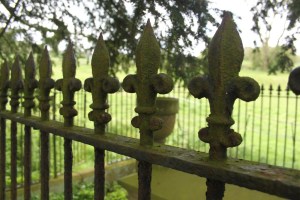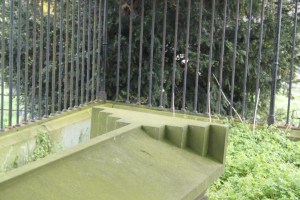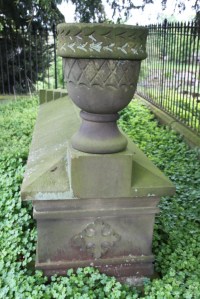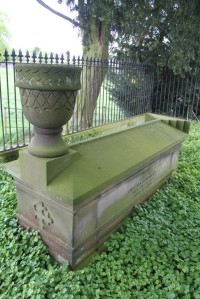Re-posted from Archaeodeath.
As part of the Past in its Place project, I am exploring the relationship between early archaeological writing and the excavation of ancient tombs. I am also interested in how antiquaries and early archaeologists are themselves commemorated.
Like many archaeologists, I am fascinated by the early barrow-diggers. Reading their reports is a sick fascination: a voyeuristic car-crash archaeology. I say this because of the mixture at excitement at the discoveries and horror at their methods, the seductive beauty of their illustrations and (sometimes) their prose, yet the gut-wrenching feeling that you are looking at a horrible ruination of fabulous archaeological remains whose context is absent or poorly recorded. Regarding images, there is a parallel with the feeling I get looking at the PAS website…. a mixture of guilt and wonder at what I am seeing.
For barrow-digging, even those rare individuals who pioneered field recording and attention to detail simply exacerbate the horror. Still, studying the earliest barrow-diggers is not simply about chastising them for their failings any more than it is about honouring ‘founding fathers’ (and yes, it is mainly men who at least get the attention), placing them on pedestals as if they were ‘visionaries’ simply for idling around burial mounds ripping out skeletons. Their reports can be read as primary sources onto the interaction between perceptions of the past and contemporary obsessions with race, class, gender and all manner of other social, cultural, economic and political dimensions of early Victorian society in Britain.
In these regards, I have a soft spot for Thomas Bateman (1821-65) , the Derbyshire ‘barrow-knight’ whose passion for barrow digging turned up some fabulous artefacts and burials relating to the prehistory and early history of the Peak District, but whose approach and interests neatly spanned the transition from antiquarianism to archaeology and perceptions of the ‘British’ but also engagements with the material remains of the earliest English. I can recommend Julien Parsons’ work on Bateman and other barrow-diggers, published in the Archaeological Journal vol. 163 for 2006. Also, a valuable resource has been constructed at the University of Sheffield from the Bateman archives.
My association with Bateman’s works goes back to my student days. As an undergraduate student, I helped John Barnett re-dig one of the prehistoric monuments subject to Bateman’s barrow digging. We found one of his tokens, left at the base of his dig. Subsequently in my own research, I was interested in the phenomenon of ‘monument reuse’, how Bateman uncovered many examples where ‘British’ barrows had early medieval graves deliberately inserted into them. I have also been interested in primary barrow burial in the seventh century and Bateman’s work at Benty Grange in particular, as part of my project, published in a paper from 1999 called ‘Placing the Dead’, looking at why specific locations were selected for reuse or for new barrow-building projects during the era of Christian conversion and kingdom formation. Later still in my research, I have discussed Bateman in the context of the origins of Anglo-Saxon archaeology. Currently, I am interested in Bateman’s work because some of the sites he dug are key to my thinking about landscape and memory in the Peak District, but also how he writes about these finds and sites.
On a recent visit, I explored some of the key monuments I will be focusing on in my work for the Past in its Place project, including the prehistoric henge of Arbor Low, around which Bateman investigated a number of barrows yielding primary and secondary interments of early medieval date. I also decided to make a pilgrimage to visit Bateman’s tomb.

Western side of the monument, commemorating Bateman’s 11-year-old daughter Sarah, who joined him in his tomb.
Bateman is a rare instance of a barrow-digger who took his occupation to configure his own mortuary commemoration. Bateman’s Gothic tomb sites, commemorating himself and his child Sarah who died the year after him, within iron railings in a private burial plot uphill and behind the chapel at Middleton-by-Youlgreave, Derbyshire.
The site is in a sorry state of disrepair and a notice asks visitors not to venture inside. However, I felt that, as I fan of Bateman, and to honour his memory, some photographs of his fabulously grim memorial would be a fitting tribute to his early archaeological endeavours.
It is a rather ugly monument that only an archaeologist could love. Central to his memorial is of course the replica of a Bronze Age collared urn, upright in a fashion that is counter to the Bronze Age mortuary tradition in which many are placed upside down over cremated human remains. Bateman’s funerary urn sits on the northern (uphill) end of the tomb, balanced awkwardly and yet a striking short-hand for Bateman’s archaeological endeavours.
Perhaps a replica of the Benty Grange helmet, among his most famous discoveries, would have been too unwieldy to sculpt and balance on his tomb? I think this is not the point. There was the long mortuary tradition in aristocratic and gentry tomb culture of urns as symbols of mourning and loss, and the use of classical urns can only rare occasions be readily adapted. Here, the urn commemorates a connection between an individual’s ‘profession’ and the primordial ‘British’ past of the Peak District. Indeed, the isolated location of the tomb might have been intended to provoke a similar association.
Certainly this is no ‘pagan’ memorial, the faith of Bateman is left undisputed in the stepped base implying a Gothic cross. Instead the crosses are situated at head-end and foot-ends of the tomb. In summary, the tomb is a messy, ungainly but remarkable biographical skeuomorphic statement in stone, honouring a very peculiar, morbid and early Victorian passion for barrow-digging and one of its chief proponents in the English Midlands and his young daughter.
RIP TB and SB!

